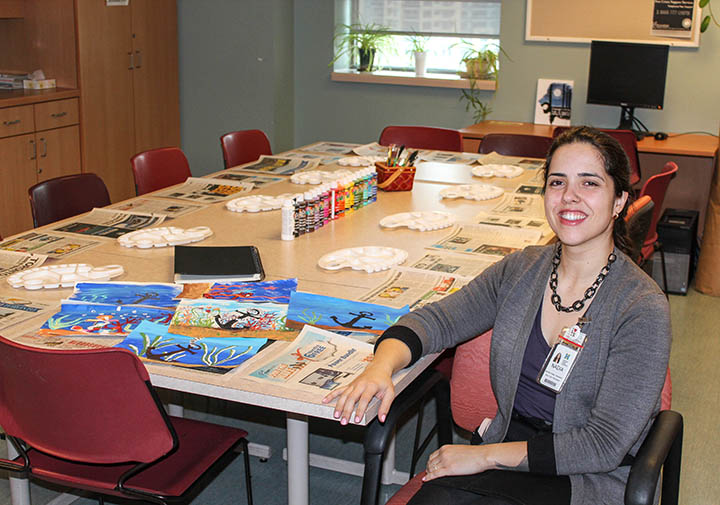Recreational therapy and the role it plays in overall health

What do you think of when you hear the word ‘therapy’? Do you think of playing a game, cooking, or painting a picture? You might if you’ve ever experienced recreational therapy!
The Canadian Therapeutic Recreation Association defines recreational therapy as “a health care profession that utilizes a therapeutic process, involving leisure, recreation and play as a primary tool for each individual to achieve their highest level of independence and quality of life.”
Using recreation and leisure activities to enhance a person’s health and wellbeing ranges depending on individual interests.
“It’s all about the person, the functionality of your body and mind doesn’t take centre stage, recreational therapy focuses on the person versus the patient,” says Nadia Gomes Bento, Recreational Therapist at North York General Hospital. “When you focus on the person, you open doors to healing that may have otherwise been closed.”
It’s more than fun and games
There is a purpose behind the activities that are specifically targeted to each person. When individuals are suffering from a physical injury or mental illness, they often need help learning, not only how to live with their disability, but to enhance their quality of life. Therapeutic Recreation (TR) can help by reducing isolation that patients might experience and encourage them to participate in leisure activities.
“Our programs are goal oriented – it’s for a purpose,” says Nadia. “I promote a holistic approach while aiming to restore and rehabilitate a person’s level of functionality and independence.”
Oftentimes participants feel hesitant in taking part but the beauty of a group session is the opportunity for collaboration and teamwork. Activities such as cooking can lead to better emotional regulation – Nadia says instead of sitting and lingering with your thoughts, simply start cooking or bring out the paint and put it down on paper.
Who is TR for?
Recreational therapists work with a wide range of individuals including children, adults, and older adults with physical, behavioral, cognitive, developmental, and intellectual disabilities. Although many people can benefit from therapeutic recreation, Nadia works with NYGH’s adult mental health population.
The types of activities may vary depending on the person. Some sample activities include stretching exercises, breathing techniques for relaxation, arts and crafts, pet visits, dancing, drama, music and group gatherings. A recreational therapist can also act as a mentor to patients who need recovery in social areas.
What do the sessions look like?
After a nurse identifies who would benefit from the program, Nadia works with them in a group setting.
Outpatient and inpatient care
The outpatient program has a pre-established schedule with programs such as The Pursuit of Meaning where participants talk about identity, forgiveness and courage. The program targets physical, cognitive, emotional, social and spiritual well-being.
Inpatient programming changes monthly, with many different activities to partake in.
You call that a pet? is a social based program. Nadia shares stories and videos of unique pets from all around the world, including someone who adopted a baby hippo.
“This program gets people talking about their own pets, connecting with each other, and there’s always a laugh or two,” says Nadia.
And, Humming your way to Health. If participants are feeling stressed or anxious, sometimes they aren’t able to sing out loud, but may be able to hum. This is a skill that can be used in everyday practice.
You can’t spell heart without art
Nadia shared a story about working with a patient who had experienced a stroke and who was waiting for long-term care. The patient felt very isolated and because of her loss of mobility, the patient couldn’t do what she used to which led to her spending most of her time in her room.
Loss of independence can be a difficult realization for many of her patients. That’s why Nadia spent a little extra time with her patient and found out she was open to painting.
“When we first started, she was the brain and I was the hand, she would pick what colors to use and what to paint, but I would be the one doing it,” says Nadia.
Slowly, she was willing to pick up the paint brush and progressed to doing it on her own and eventually worked up the confidence to write her own name.
“She didn’t have great fine motor skills and her hands would often shake, causing her to paint outside the lines, something she didn’t like very much – my trick was to grab some white out,” explains Nadia.
Little by little, they made a whole art mural on her wall.
It’s no surprise that Nadia was drawn to the field of recreational therapy. She creates a safe environment and breaks down walls to focus on the person using small attainable steps.
“I’m a strong believer that you need to fill your life with meaningful activity – things that bring you joy and purpose,” says Nadia.
